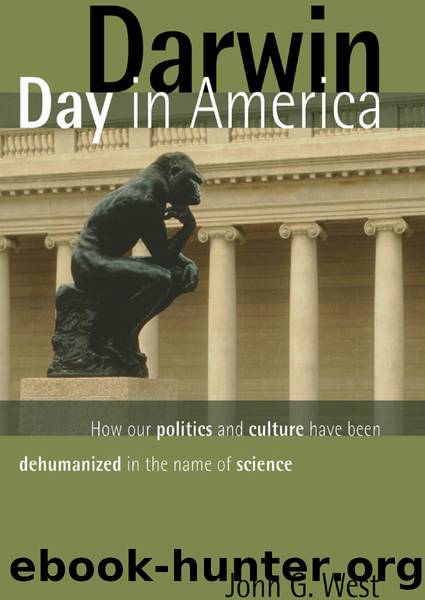Darwin Day in America: How Our Politics and Culture Have Been Dehumanized in the Name of Science by John G. West

Author:John G. West [West, John G.]
Language: eng
Format: epub
Tags: Philosophy, Science
ISBN: 9781933859323
Google: xLzaAAAAMAAJ
Goodreads: 1252775
Publisher: ISI Books
Published: 2007-01-15T08:00:57+00:00
13
Sex Miseducation
In Sexual Behavior in the Human Male, Alfred Kinsey excoriated existing sex-education efforts as too little, too late. He disparaged female teachers assigned to teach the subject for being mothers who were probably much less sexually experienced than their male students. âMany of these women, including some high school biology teachers, believe that the ninth or tenth grade boy is still too young to receive any sex instruction when, in actuality, he has a higher rate of [sexual] outlet and has already had a wider variety of sexual experience than most of his female teachers ever will have,â Kinsey snapped.1
He then acknowledged that âwhether there should be sex instruction, and what sort of instruction it should be, are problems that lie outside the scope of an objective scientific studyââbut that did not stop him from offering advice. âIt is obvious,â he explained, âthat the development of any curriculum that faces the fact [of adolescent sexual behavior] will be a much more complex undertaking than has been realized by those who think of the adolescent boy as a beginner, relatively inactive, and quite capable of ignoring his sexual development.â Kinsey suggested that sex education begin no later than âten or twelve, and in many instances at some earlier age.â2
Kinseyâs vision of a transformed sex-education system began to be realized after his death when, in 1964, Mary Calderone and Lester Kirkendall cofounded the Sex Information and Education Council of the United States (SIECUS) to promote comprehensive sex instruction in kindergarten through high school.3 (The title of the group was later changed slightly to the Sexuality Information and Education Council of the United States.) Early SIECUS board members included Kinsey associates Wardell Pomeroy and Harriet Pilpel. Pomeroy was coauthor of Kinseyâs original published reports, and Pilpel was a lawyer who worked on a sex-law-reform project for Kinsey.4 She later served as a vice president of the American Civil Liberties Union.
SIECUS forged ties with liberal members of the clergy, and one of its founding board members was a minister affiliated with the National Council of Churches. Like Kinsey, SIECUS cultivated a public image of probity and moderation, assuring parents and journalists that its goal was to educate people about the medical and scientific facts of sexuality so that they âmay be aided toward responsible use of the sexual faculty.â5 Far from promoting permissiveness, SIECUS claimed to be on a crusade to protect the nationâs children from the destructive effects of unwholesome sex. Its purpose was to champion âwholesome knowledge about sex ⦠and to counteract the violent, dirty, threatening images of sex thrust at children from all sides.â6
Executive director Mary Calderone reinforced her organizationâs image as an upholder of societyâs mores. A Quaker (a fact she did not hesitate to point out to reporters), Calderone spoke of her âprofound belief that sex belongs primarily in marriageâ and belittled as âblind alleysâ such sex behaviors as âcompulsive promiscuousness, homosexuality, âfun and games,â and exploitationâ (she later changed her mind about homosexuality).7 Calderone emphasized that discussions of sex should notâindeed, could notâignore the importance of values.
Download
This site does not store any files on its server. We only index and link to content provided by other sites. Please contact the content providers to delete copyright contents if any and email us, we'll remove relevant links or contents immediately.
The Secret History by Donna Tartt(18743)
The Social Justice Warrior Handbook by Lisa De Pasquale(12080)
Thirteen Reasons Why by Jay Asher(8736)
This Is How You Lose Her by Junot Diaz(6700)
Weapons of Math Destruction by Cathy O'Neil(6084)
Zero to One by Peter Thiel(5637)
Beartown by Fredrik Backman(5545)
The Myth of the Strong Leader by Archie Brown(5374)
The Fire Next Time by James Baldwin(5199)
How Democracies Die by Steven Levitsky & Daniel Ziblatt(5096)
Promise Me, Dad by Joe Biden(5036)
Stone's Rules by Roger Stone(4989)
100 Deadly Skills by Clint Emerson(4798)
A Higher Loyalty: Truth, Lies, and Leadership by James Comey(4796)
Rise and Kill First by Ronen Bergman(4658)
Secrecy World by Jake Bernstein(4593)
The David Icke Guide to the Global Conspiracy (and how to end it) by David Icke(4557)
The Farm by Tom Rob Smith(4404)
The Doomsday Machine by Daniel Ellsberg(4375)
